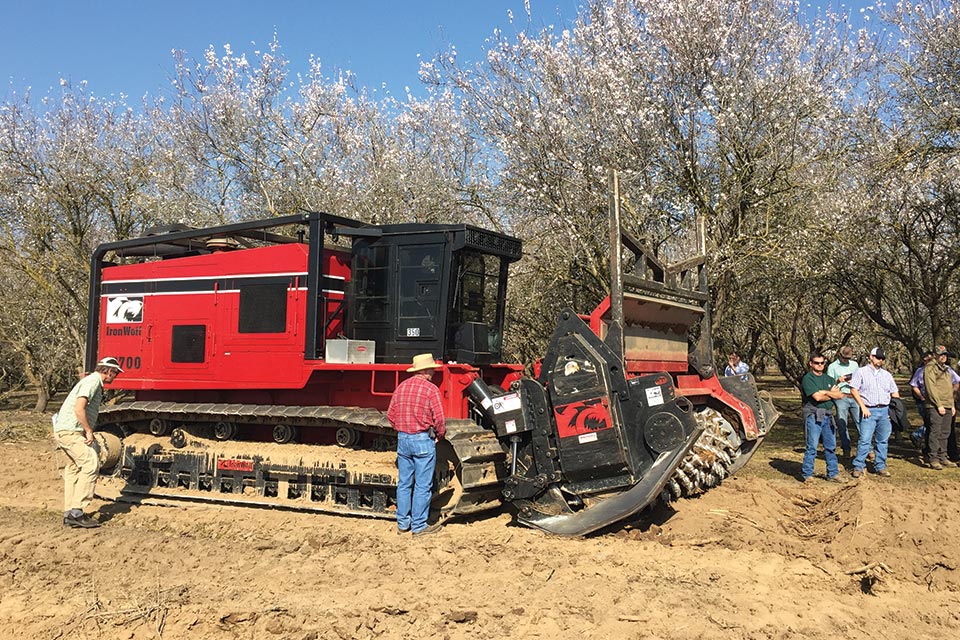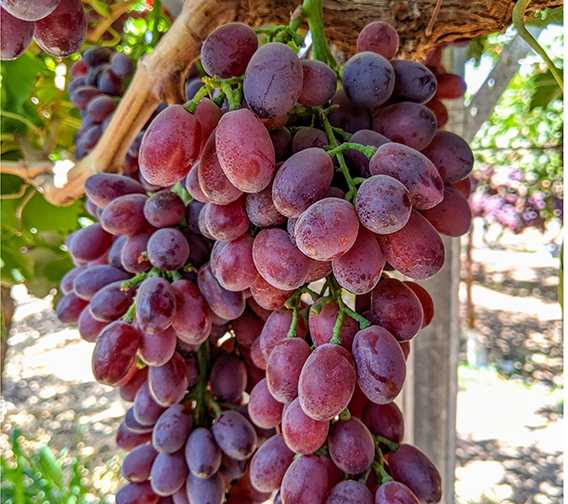Whole Orchard Recycling Could Improve Soil Fertility

Here is a row of mature almond trees that just encountered the Slasher (in background) from IronWolf Manufacturing.
Editor’s Note: An original version of this story was posted to GrowingProduce.com last month. The story below contains new and updated information, as well as additional photos. This story will also be appearing in print in the May issue of Western Fruit Grower® magazine’s “California Nut Report.”
Researchers are looking at new methods to remove trees from the orchard that could prove beneficial to the soil.
When almond orchards are removed, the biomass has to go somewhere. In the past, old orchards were pushed and burned. However, air quality restrictions led to chipping the wood and sending that orchard biomass to cogeneration plants to be burned for energy.
However, in California the biomass industry has fallen on tough times. Many cogeneration facilities have shut down as Public Utility Regulatory contracts expired and other forms of energy became viable, inexpensive options.
Now, researchers are discovering the value of whole orchard recycling — returning the organic matter to the soil.
Enter The Slasher
In 2008, Brent Holtz, University of California Cooperative Extension County Director and Farm Advisor in San Joaquin County, began trialing a machine called the Slasher, which is made by IronWolf Manufacturing of Noble, OK.
The Slasher grinds up whole trees and returns the wood chips to the soil. The machine is basically a 50-ton rototiller, according to Holtz.
“The results since 2008 have been good,” he says. “The woody material didn’t stunt the trees.”
In fact, after about three years, the soil nutrient content began to improve as the wood began breaking down. And, with the number of cogeneration plants closing in recent years, the fact that growers have an alternative solution for their orchard waste is welcome news.
The process of whole orchard recycling is expensive, but Holtz says there will likely be opportunities for growers to get compensated for putting carbon back into the ground. A new USDA-funded pilot program has been created to allow almond growers to enter the cap-and-trade market and sell carbon credits to companies and industries trying to meet their emission targets.

Since this demonstration, IronWolf is adding a drum to the Slasher – which can be used with virtually any tree crop – to grind up the larger chunks of wood left behind by the original unit into smaller pieces for quicker decomposition.
Slasher vs. Tub Grinder
Holtz is now in the process of conducting additional research to determine the best method of grinding up a large amount of woody material to leave in the orchard.
Tub grinders have typically been used to grind the trees to be sent to cogeneration plants, but the researchers are now looking at the machines’ potential to return the wood chips to the orchard floor.
In a recent demonstration, a tub grinder was used to grind up 16 rows in an orchard in Chowchilla, while 24 rows were ground up using the Slasher. There also will be control rows as part of the trial where none of the wood chips are put back in the ground.
With the Slasher, all the wood material gets incorporated into a 10-foot strip down the tree row, and some of the chunks are quite large. The space between the tree rows doesn’t receive any of the organic matter. These larger pieces could take quite a few years to decompose, Holtz notes.
However, since that demonstration, the president of IronWolf, Todd Howe, said his company is working on attaching drum that attaches to the Slasher and grinds the tree up into smaller pieces.
Howe said the refined unit is being tested in citrus trees. The Slasher can work on virtually any tree crop, he says.
One benefit of the Slasher is that unlike the tub grinder, it gets the job done without the need for extra machinery. It goes forward to grind up the trees, then backwards and acts as a rototiller to incorporate the wood chips into the ground.
The tub grinder, on the other hand, only grinds the trees, and was designed to be used with the cogeneration facilities. If you want to put the chips back in the field, it could be a five-step process using different machines, including excavators, loaders, the tub grinder, spreaders, and a disk or rototiller for incorporation. The researchers are in the process of looking at the carbon budget by comparing the one machine versus the five.

The newest model of the 100,000-pound Slasher is the 700B, and purchased new it costs about $1.3 million. However, IronWolf President Todd Howe says a Slasher can be mounted on a heavy-duty bulldozer, and sold separately the unit costs less than $500,000.
New Technology Isn’t Cheap
No grower has actually purchased a Slasher yet, no doubt because of the relative newness of the technology and its expense. The one demonstrated in Chowchilla is the newest model, the IronWolf Slasher 700B. Purchased new it costs about $1.3 million, says Howe.
However, if growers already have a heavy-duty bulldozer, they can mount the Slasher unit. Sold separately, the IronWolf Slasher costs between $450,000 and $500,000.
Holtz estimates running the Slasher could cost about $1,500 per acre, compared to about $1,000 per acre for a tub grinder. Holtz notes that if someone were to purchase the Slasher and provide a service to growers, the expense would be lowered some.
Tree size is another factor to consider. The Slasher grinds trees in place, which, as mentioned, concentrates the spread of the chips into a 10-foot strip. That means when grinding larger trees, such as the 25- to 35-year-old almond trees in the Chowchilla trial, a large amount of biomass will be left in one place.
Such large trees, which Howe estimated had an average diameter of about 27 inches, take a fair amount of time to chew up. He said he could do about two acres a day. He could double the speed, tackling four acres a day, if the trees were more like 22 inches.
Howe says he’s encouraged by Holtz’s results, which show the Slasher is the only unit that can go down below the surface of the soil and take care of tree roots. Without the availability of cogeneration facilities, growers who used to get paid so much per pound for wood pulp are going to have to essentially pay so much per pound.
Holtz says his 2008 trial established some excellent groundwork, but the current trials, once complete, should provide even more insight.
“We’re forming a research team to look at this all in depth,” Holtz says.
Howe is confident the Slasher will be the best option for growers who are interested in replanting older orchards with newer varieties on far more high-yielding production systems.
“Bigger growers are looking into the future and they’re getting ahead of it,” he says. “They know they have to replace their trees, and there’s going to be a change in the way people manage crops based on when [orchards should be replanted].” ●









